1994 CHEVROLET CORVETTE fuel
[x] Cancel search: fuelPage 140 of 274
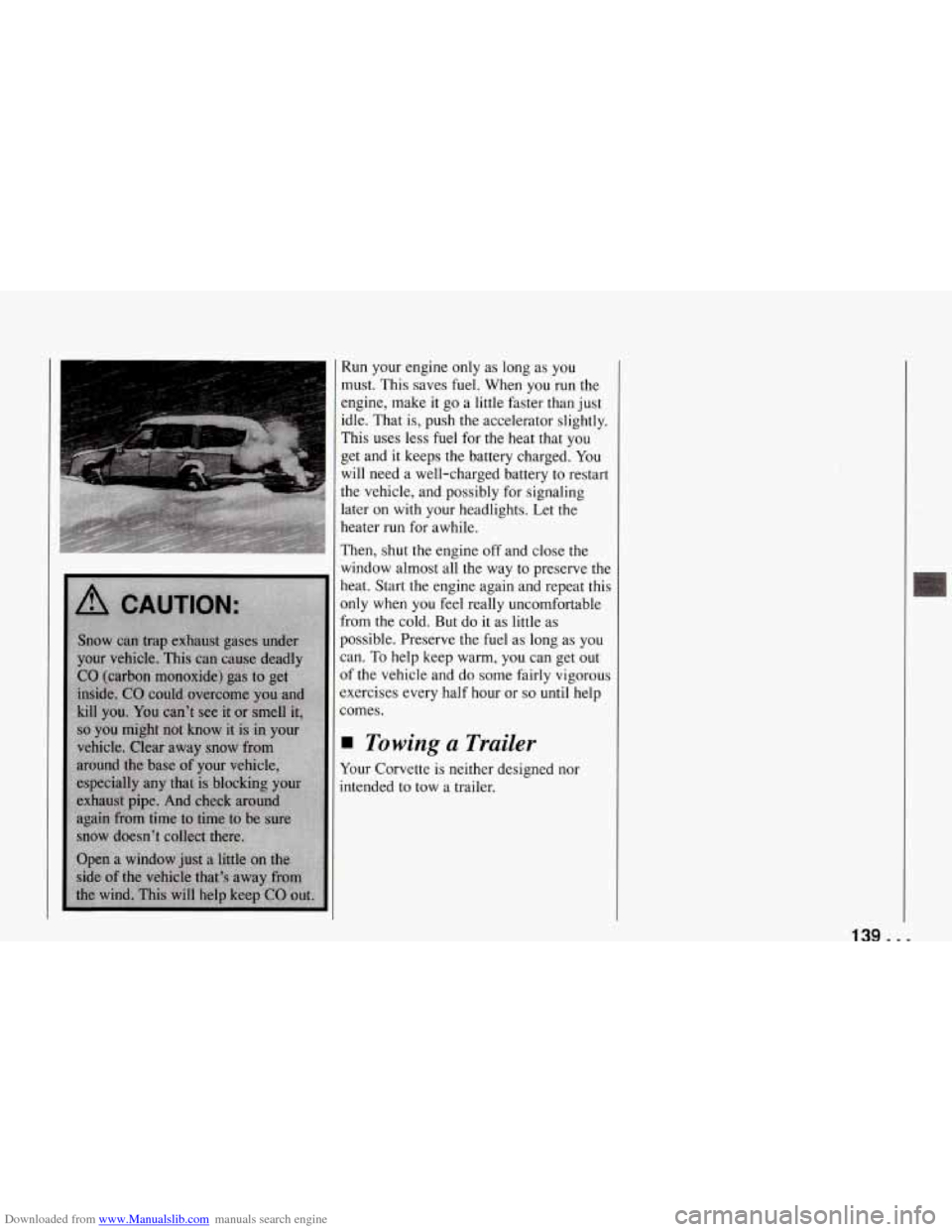
Downloaded from www.Manualslib.com manuals search engine Run your engine only as long as you
must. This saves fuel. When you run the
engine, make it go a little faster than just
idle. That is, push the accelerator slightly.
This uses less fuel for the heat that you
get and it keeps the battery charged. You
will need a well-charged battery to restart
the vehicle, and possibly for signaling
later on with your headlights. Let the
heater run for awhile.
Then, shut the engine
off and close the
window almost all the way to preserve the
heat. Start the engine again and repeat this
only when you feel really uncomfortable
from the cold. But do it as little as
possible. Preserve the fuel as long as you
can.
To help keep warm, you can get out
of the vehicle and do some fairly vigorous
exercises every half hour or
so until help
comes.
Towing a Trailer
Your Corvette is neither designed nor
intended to tow a trailer.
139 ...
Page 172 of 274

Downloaded from www.Manualslib.com manuals search engine Here you will find information
about the care of your Corvette
.
This part begins with service
and fuel information. and then it
shows how
to check important
fluid and lubricant levels
. There
is also technical information
about your vehicle. and a section devoted
to its
appearance care
.
Part 6
Service & Appearance Care
Service ........................................................
Fuel ..........................................................
Checking Things under the Hood ...................................
HoodRelease .................................................
Engineoil .................................................
Aircleaner ........................... ...................
Automatic Transmission Fluid ..................................
Manual Transmission Fluid ......................................
Hydraulic Clutch ...............................................
RearAxle ....................................................
Enginecoolant ................................................
Power Steering Fluid ...........................................
Windshield Washer Fluid ........................................
Brake Master Cylinder ..........................................
Battery ......................................................
Bulb Replacement ...............................................
Windshield Wiper Blades ..........................................
Tires ..........................................................
Appearancecare ................................................
Appearance Care Materials Chart ...................................
Vehicle Identification Number (VIN) ................................
Service Parts Identification Label ...................................
Add-on Electrical Equipment ......................................
Fuses and Circuit Breakers ........................................
Replacement Bulbs ..............................................
Capacities and Specifications ...................................
LoadingYourVehicle ............................................
172
173
175
175
178
182 184
186
187
188
188
191
192
193
195
195
202
202
204
210
217
218
218
218
219
223
224
171 ..
Page 174 of 274
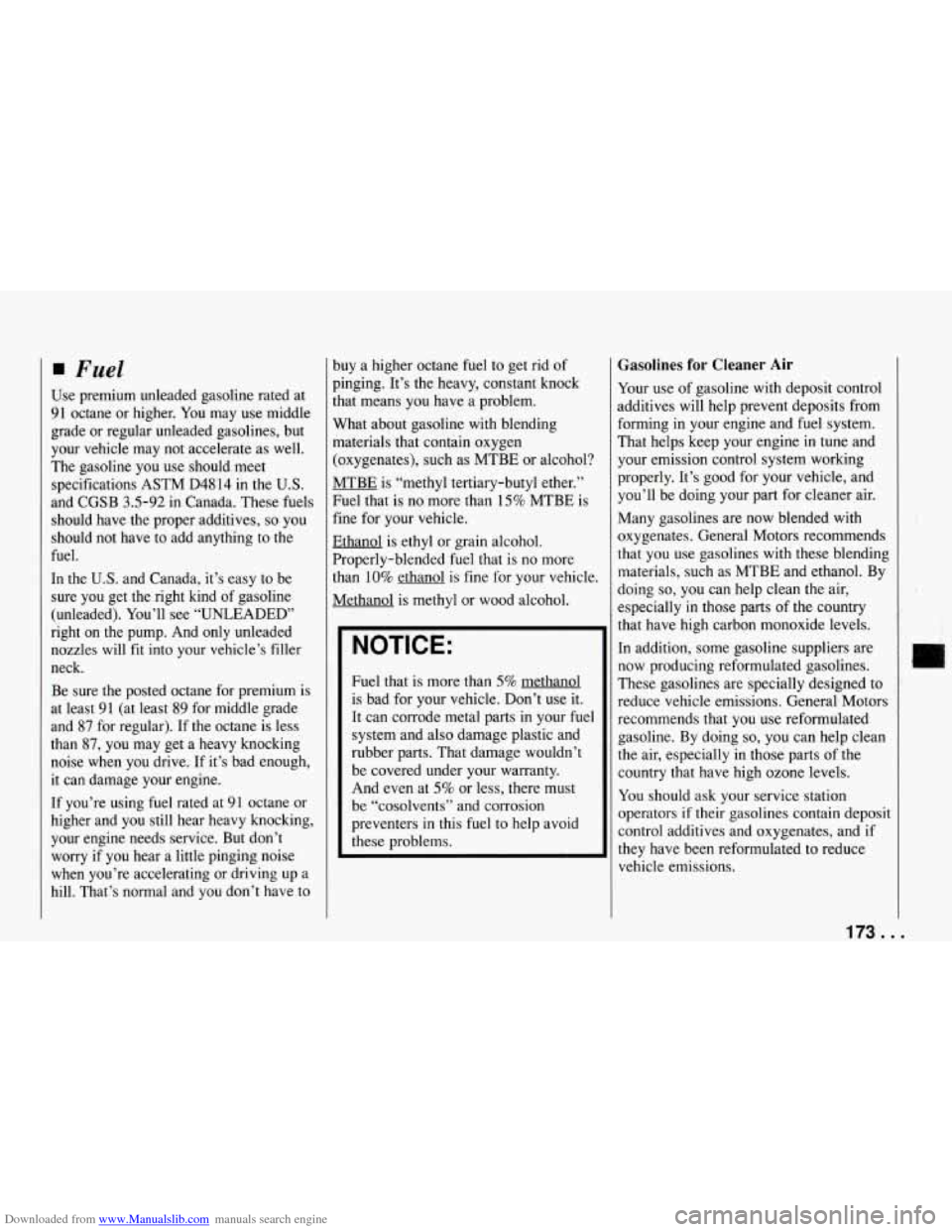
Downloaded from www.Manualslib.com manuals search engine Fuel
Use premium unleaded gasoline rated at
91 octane or higher. You may use middle
grade or regular unleaded gasolines, but
your vehicle may not accelerate as well.
The gasoline you use should meet
specifications ASTM D4814 in the
U.S.
and CGSB 3.5-92 in Canada. These fuels
should have the proper additives,
so you
should not have to add anything to the
fuel.
In the U.S. and Canada, it’s easy to be
sure you get the right kind of gasoline
(unleaded). You’ll see “UNLEADED’
right on the pump. And only unleaded
nozzles will fit into your vehicle’s filler
neck.
Be sure the posted octane for premium
is
at least 91 (at least 89 for middle grade
and 87 for regular). If the octane is less
than
87, you may get a heavy knocking
noise when you drive. If it’s bad enough,
it can damage your engine.
If you’re using fuel rated at 91 octane or
higher and you still hear heavy knocking,
your engine needs service. But don’t
worry if you hear a little pinging noise
when you’re accelerating or driving up a
hill. That’s normal and you don’t have to
buy a higher octane fuel to get rid of
pinging. It’s the heavy, constant knock
that means you have a problem.
What about gasoline with blending
materials that contain oxygen
(oxygenates), such as MTBE or alcohol?
MTBE is “methyl tertiary-butyl ether.’’
Fuel that is no more than 15% MTBE is
fine for your vehicle.
Ethanol is ethyl or grain alcohol.
Properly-blended fuel that is no more
than
10% ethanol is fine for your vehicle.
Methanol
is methyl or wood alcohol.
NOTICE:
Fuel that is more than 5% methanol
is bad for your vehicle. Don’t use it.
It can corrode metal parts
in your fuel
system and also damage plastic and
rubber parts. That damage wouldn’t
be covered under your warranty.
And even at
5% or less, there must
be “cosolvents” and corrosion
preventers in this fuel to help avoid
these problems.
Gasolines for Cleaner Air
Your use of gasoline with deposit control
additives will help prevent deposits from
forming in your engine and fuel system.
That helps keep your engine
in tune and
your emission control system working
properly. It’s good for your vehicle, and
you’ll be doing your part for cleaner air.
Many gasolines are now blended with
oxygenates. General Motors recommends
that you use gasolines with these blending
materials, such as MTBE and ethanol. By
doing
so, you can help clean the air,
especially in those parts of the country
that have high carbon monoxide levels.
In addition, some gasoline suppliers are
now producing reformulated gasolines.
These gasolines are specially designed to
reduce vehicle emissions. General Motors
recommends that you use reformulated
gasoline. By doing
so, you can help clean
the air, especially in those parts of the
country that have high ozone levels.
You should ask your service station
operators
if their gasolines contain deposit
control additives and oxygenates, and if
they have been reformulated to reduce
vehicle emissions.
173 ...
Page 175 of 274
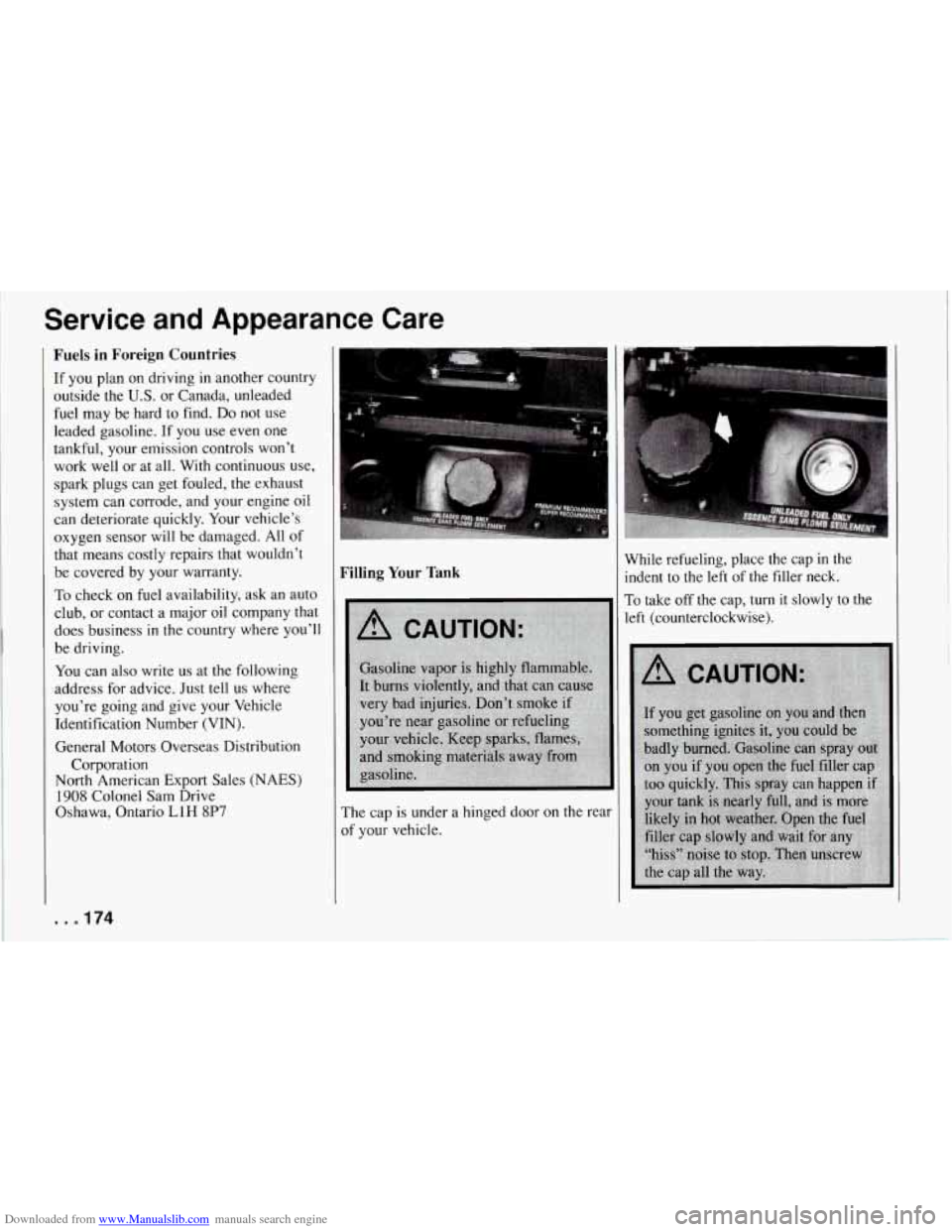
Downloaded from www.Manualslib.com manuals search engine Service and Appearance Care
Fuels in Foreign Countries
If you plan on driving in another country
outside the
U.S. or Canada, unleaded
fuel may be hard to find.
Do not use
leaded gasoline. If you use even one
tankful, your emission controls won’t
work well or at all. With continuous use,
spark plugs can get fouled, the exhaust
system can corrode, and your engine oil
can deteriorate quickly. Your vehicle’s
oxygen sensor will be damaged. All of
that means costly repairs that wouldn’t
be covered by your warranty.
To check on fuel availability, ask an auto
club, or contact a major oil company that
does business
in the country where you’ll
be driving.
You can also write us at the following
address for advice. Just tell
us where
you’re going and give your Vehicle
Identification Number (VIN).
General Motors Overseas Distribution
North American Export Sales
(NAES)
1908 Colonel Sam Drive
Oshawa, Ontario LlH 8P7
Corporation
. . .174
Filling
Your Tank
The cap is under a hinged door on the rear
of your vehicle. While
refueling, place the cap in the
indent to the left of the filler neck.
To take
off the cap, turn it slowly to the
left (counterclockwise).
Page 176 of 274
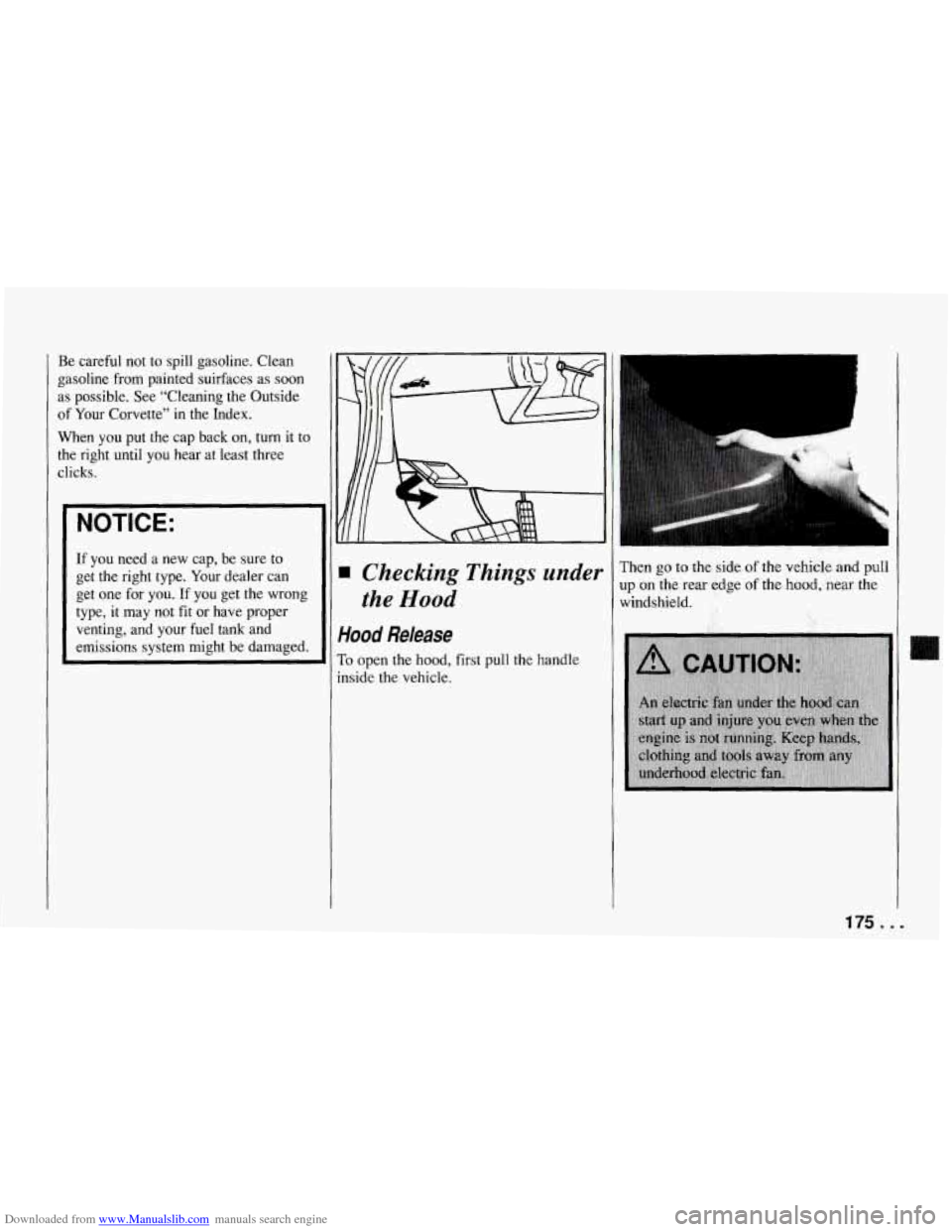
Downloaded from www.Manualslib.com manuals search engine Be careful not to spill gasoline. Clean
5asoline from painted suirfaces
as soon
1s possible. See “Cleaning the Outside
If Your Corvette’’ in the Index.
When you put the cap back on, turn it to
:he right until you hear at least three
:licks.
NOTICE:
If you need a new cap, be sure to
get the right type. Your dealer can
get one for you.
If you get the wrong
type, it may not fit or have proper
venting, and your fuel tank and
emissions system might be damaged.
I Checking Things under
the Hood
Hood Release
ro open the hood, first pull the handle
inside the vehicle.
L
Fhen go to the side of the vehicle and pull
~p on the rear edge of the hood, near the
windshield.
175 ...
Page 179 of 274
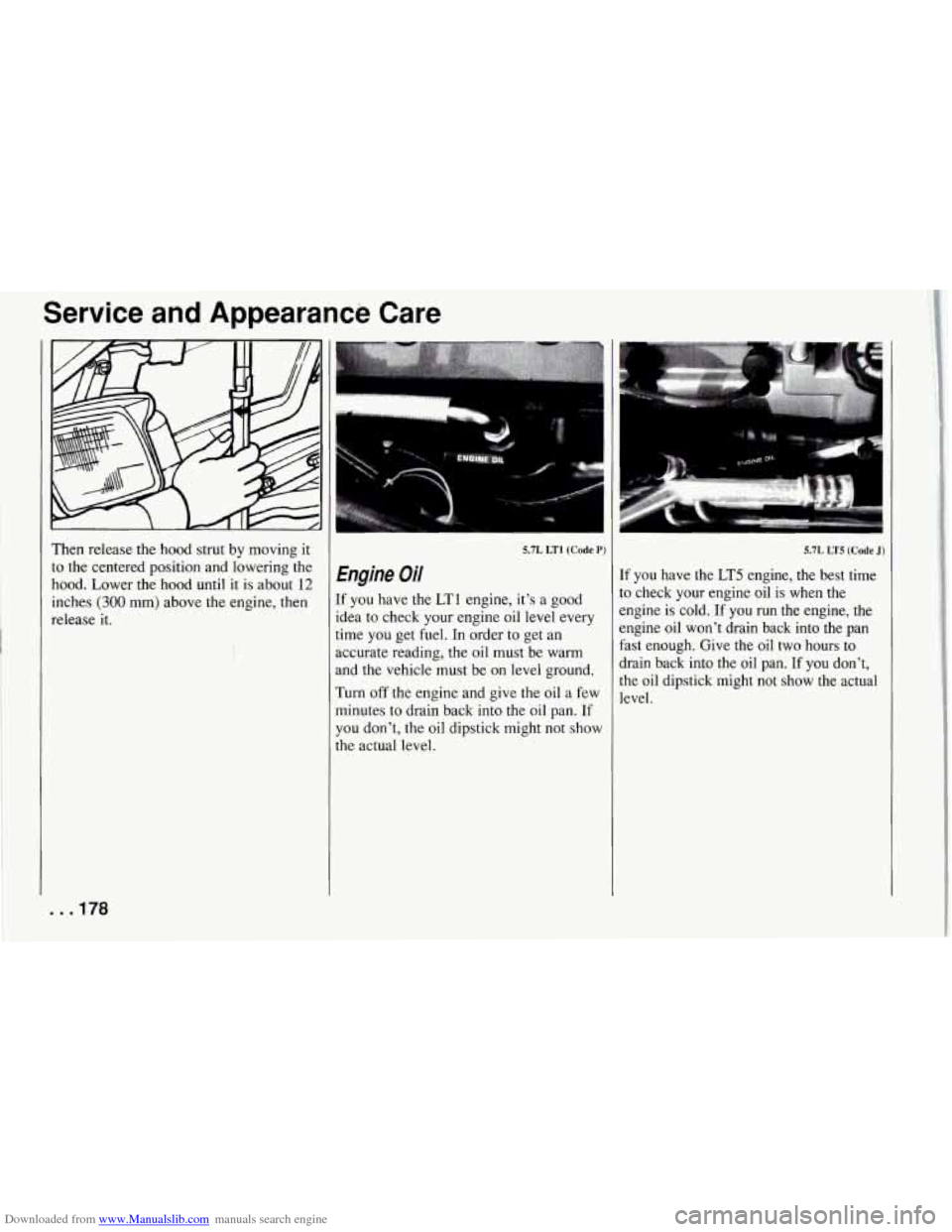
Downloaded from www.Manualslib.com manuals search engine Service and Appearance Care
Then release the hood strut by moving it
to the centered position and lowering the
hood. Lower the hood until it is about
12
inches (300 mm) above the engine, then
release it.
- - 178
I
!
5.7L LTl (Code P)
Engine Oil
If you have the LTl engine, it’s a good
idea to check your engine oil level every
time you get fuel. In order to get an
accurate reading, the oil must be warm
and the vehicle must be on level ground.
Turn off the engine and give the oil a few
minutes to drain back into the oil pan.
If
you don’t, the oil dipstick might not show
the actual level. d
tl
It
rain
le oi
:vel.
5.7L LT5 (Code J)
f you have the LT5 engine, the best time
3 check your engine oil is when the
ngine is cold. If you run the engine, the
ngine oil won’t drain back into the pan
ast enough. Give the oil two hours to
back into the oil pan. If you don’t,
1 dipstick might not show the actual
Page 181 of 274
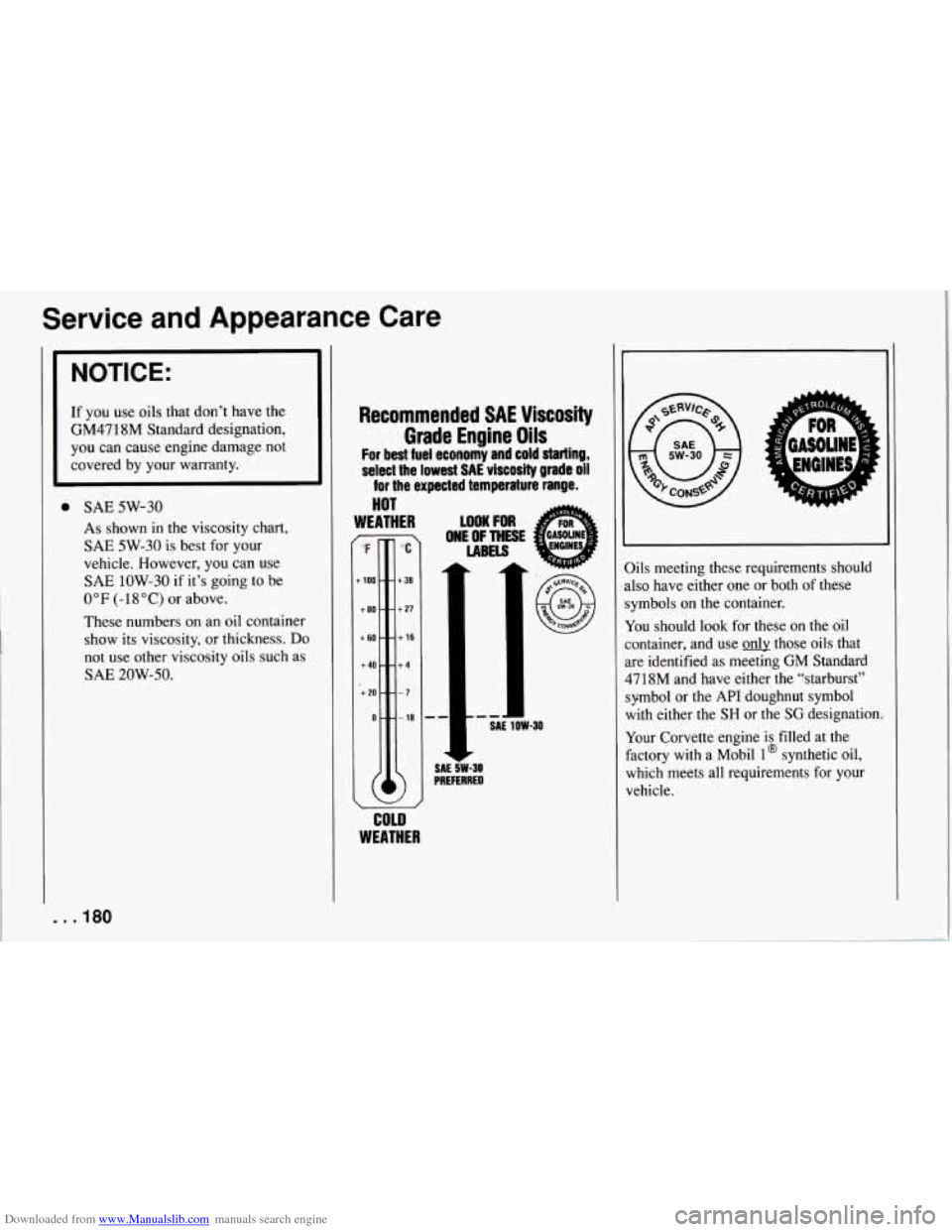
Downloaded from www.Manualslib.com manuals search engine Service and Appearance Care
I
NOTICE:
If you use oils that don’t have the
GM4718M Standard designation,
you can cause engine damage not
covered by your warranty.
0 SAE 5W-30
As shown in the viscosity chart,
SAE 5W-30 is best for your
vehicle. However, you can use
SAE 1OW-30 if it’s going to be
0°F (-18°C) or above.
These numbers
on an oil container
show its viscosity, or thickness.
Do
not use other viscosity oils such as
SAE 20W-50.
. .I80
Recommended SAE Viscosity
Grade Engine Oils
For best fuel economy and cold starting,
.select the lowest SAE viscosity grade oil
for the expected temperature range.
HOT
WEATHER
/
WEATHER
r
COLD
WOK FOR
LABELS
ONE OFTHESE @
1
-r
SAEZ-30
PREFERRED
Oils meeting these requirements should
also have either one or both of these
symbols
on the container.
You should look for these
on the oil
container, and use
o& those oils that
are identified as meeting GM Standard
4718M and have either the “starburst”
symbol or the
API doughnut symbol
with either the
SH or the SG designation.
Your Corvette engine is filled at the
factory with a Mobil
l@ synthetic oil,
which meets all requirements for your
vehicle.
Page 204 of 274
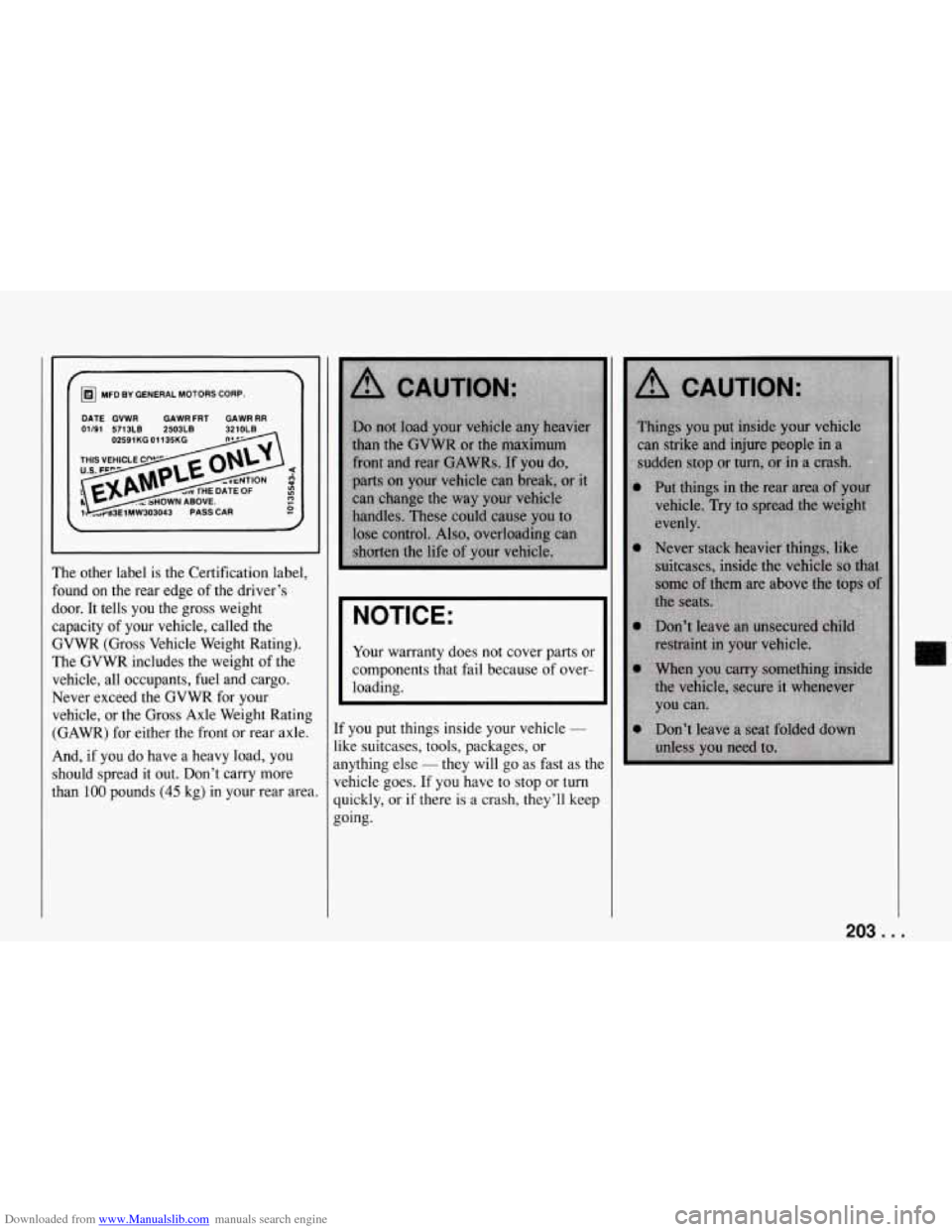
Downloaded from www.Manualslib.com manuals search engine MFD BY GENERAL MOTORS CORP.
01/91 5713LB 2503LB DATE GVWR
GAWRFRT GAWRRR
The other label is the Certification label,
found on the rear edge of the driver’s
door. It tells you the gross weight
capacity of your vehicle, called the
GVWR (Gross Vehicle Weight Rating).
The GVWR includes the weight of the
vehicle, all occupants,
fuel and cargo.
Never exceed
the GVWR for your
vehicle, or the Gross Axle Weight Rating
(GAWR) for either the front or rear axle.
And, if you do have a heavy load, you
should spread it out. Don’t carry more
than
100 pounds (45 kg) in your rear area.
I NOTICE:
I
Your warranty does not cover parts or
components that fail because of over-
loading.
~~
If you put things inside your vehicle -
like suitcases, tools, packages, or
anything else
- they will go as fast as the
vehicle goes. If you have to stop or
turn
quickly, or if there is a crash, they’ll keep
going.
203. . .